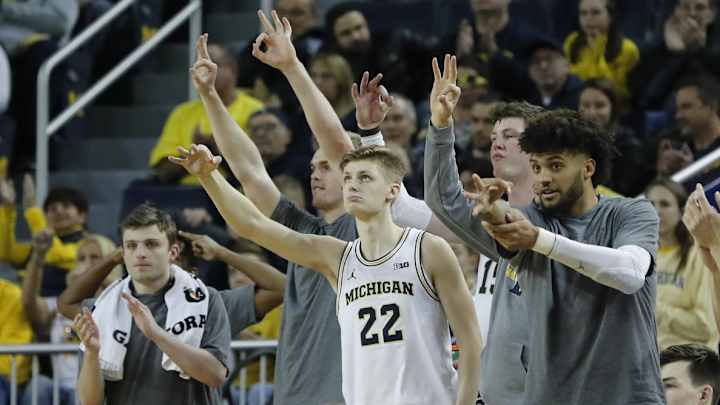Analysis: What Cole Bajema's Departure Means For Michigan Basketball

David DeJulius, Colin Castleton and now Cole Bajema have left the program, and while Michigan has gained a grad-transfer in Mike Smith, the Wolverines are down a net of two players for next year's team. Add in the near-misses at the 11th hour of five-stars Josh Christopher and Isaiah Todd and U-M now finds itself with 11 scholarship players for 2020-21 (a school can have 13), but just four set to compete at the '1' and '2' positions.
Would Bajema have been an impact player?
The 6-7, 175-pounder played in just 10 games as a freshman, earning only seven minutes in Michigan's final 17 games. At first glance, Bajema's departure might be met with a shrug, 'What's the big deal?' but as this program has demonstrated time and again, players often make big leaps from their freshman to sophomore seasons, and Bajema had a role to play.
Possessing perhaps the most natural shooting stroke on the team, Bajema was seen as a potential three-point specialist for the Wolverines next year, someone that could have earned 8-12 minutes at the '2' or the '3', spelling projected starters Eli Brooks (at the '2') and Franz Wagner (at the '3'). And Michigan could have used the help - the Maize and Blue ranked 141st nationally in 2020 connecting on threes, at just 33.9%, their lowest clip since 2010 (29.7%).
There was some hope Bajema could have been the next Duncan Robinson, shooting better than 40.0% from behind the arc (Robinson made 42.0% from 2016-18, including a ridiculous 45.2% in 2016).
There is no telling where Bajema would have been body-wise (he needed to add 15-20 pounds) or defensively, but from a depth standpoint alone, he was poised to soak up a few important minutes, minutes that now might land with junior Adrien Nunez or freshmen Jace Howard and Terrence Williams.
What does this mean for Michigan's freshmen?
A lot more playing time, by necessity. Rookie Zeb Jackson is one of only four remaining Wolverines at the '1' and '2', joining Smith, Brooks and Nunez, while Howard and Williams will likely be thrust into playing time as a reserve for Wagner at the '3' and potentially even see some minutes at the '2' if they are versatile enough.
Michigan got by on a three-man rotation at the '1' and '2' this past year, relying on Zavier Simpson, Brooks and DeJulius, but it wasn't ideal. If Simpson had a bad night or on days when two of the three were off, U-M found itself in trouble.
One of the excitements over next season was that with Smith, Brooks, Christopher, Bajema and Jackson, Michigan would have a plethora of options against any given opponent, and that depth would foster competitive juices and give coach Juwan Howard more to work with. Now, Howard will have to make due with an Ivy League grad-transfer in Smith, a secondary scorer in Brooks (but potentially more than that as a senior), throw-in Nunez, and the first-year Jackson.
At the '3', Wagner could be an All-American as a sophomore, but not even the German transport can play 40 minutes per night. Of course, don't be surprised if Howard tries - he played Simpson 35.7 minutes per game in conference play. Isaiah Livers, if he returns for his senior season, could see time at the '3' but he and junior Brandon Johns Jr. are Michigan's only two true '4's.
Thus Jace Howard (6-8, 210) and Williams (6-6, 215) will likely have to play significantly as Wagner's backup.
While there is plenty of talent in Jackson, Williams and Jace Howard, all three were seen as part-time contributors as freshmen (center Hunter Dickinson, and had they signed, Todd and Christopher, were viewed as the high-end impact rookies). Instead, all three may have to play big roles for the Maize and Blue next season.
How else will this affect the rotation?
Teams often employ 8-man rotations and that looks like Smith, Brooks and Jackson at the '1' and '2', Wagner at the '3', Livers and Johns at the '4' and Dickinson and senior Austin Davis at the '5'. If Brooks, Wagner and Livers all take a big step forward, Michigan will still have one of the best foundational cores in the Big Ten.
U-M also needs Smith to be an impact transfer, and Jackson, Williams and Dickinson to be freshmen in the vein of Mitch McGary, Nik Stauskas and Glenn Robinson III (they combined for 83 minutes and 29.5 points per game), not like Livers, Brooks and Jordan Poole did as rookies in 2017-18 when they combined for 38.7 minutes and 11.8 points per game.
Michigan is just one injury or ineffective player in the backcourt away from needing Nunez to play meaningful minutes or turning to walk-ons.
U-M could still add a grad-transfer to the mix (it needs to) but the realistic possibilities are dwindling. There was some talk that come May 20-21, there could be a slew of new transfers on the market as momentum was building for the NCAA to grant first-time transfers immediate eligibility, however, recent reports believe the NCAA will not do so, leaving few options for Michigan.
What this all means is that Howard's roster will have a razor thin margin for error in 2020-21. Injuries, even just one important injury, would derail the Wolverines, while Michigan needs some breaks to go its way.
Just four weeks ago, it appeared U-M would have the most talented roster in the Big Ten and one of the five-best rosters in the country. A month later, the roster is no longer among the four best in the conference.
